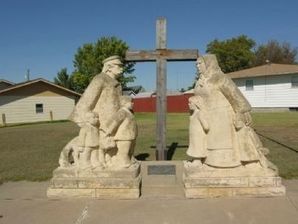Victoria
Nowhere in America were two colonies more unlike than those that came here. Scarlet-coated Britishers who chased antelope on bob-tailed ponies were joined by frugal and hard-working German-Russian immigrants. A Scotsman, George Grant, with 69,000 acres purchased from the railway, offered country estates to aristocrats. The immigrants came for religious freedom and to escape the czar’s army. Cricket and Hays City dance halls delighted one colony, homestead rights and the steppe-like prairie the other. Victoria, established 1873, was named for a queen and laid out by a London architect. Herzog, just north, established 1876, was built of sod and named for a Volga village. By 1880, most of the aristocrats had moved on, and Herzog took over Victoria. Achievements here were: introduction of Aberdeen Angus cattle to the U.S. by Grant; pioneer crops of hard winter wheat by the immigrants.
Victoria now includes both towns. Its Catholic church, St. Fidelis, is widely known as the “Cathedral of the Plains.” In a cemetery one-fourth mile west are graves of track workers massacred by Cheyennes in 1867.
(See illustration of Cathedral on other side)




